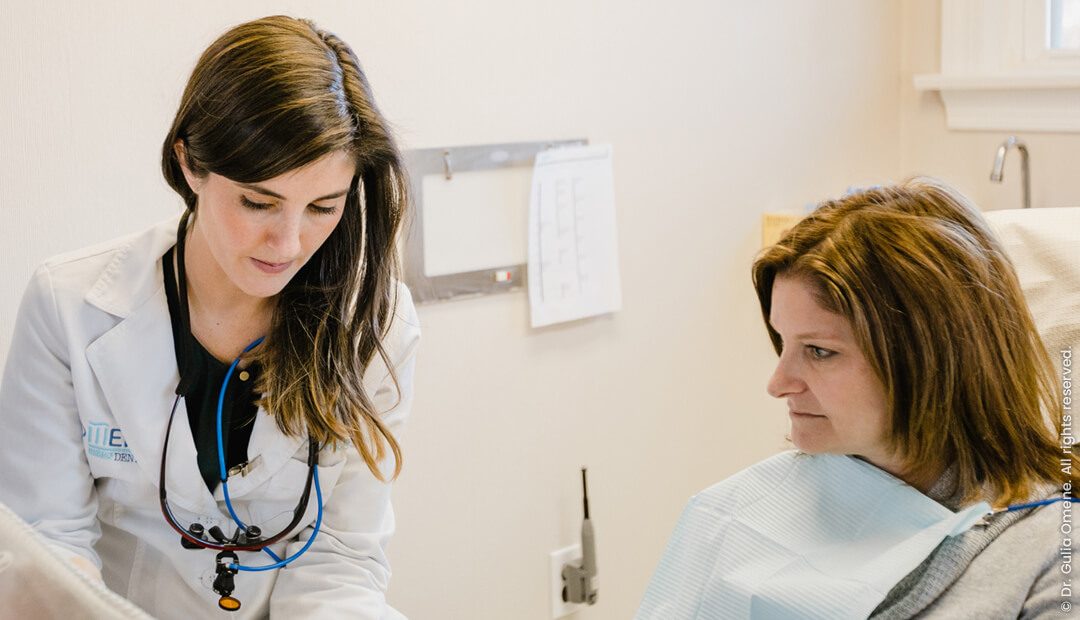To X-Ray or Not?
In this post we are going to touch upon another ‘hot button’ issue in dentistry: x-rays. It has been on our minds a lot as we get ready to make the big transition from old-fashioned, film x-rays to digital x-rays at Omene Family and Cosmetic Dentistry. In practice I have found that patients’ perceptions of dental x-rays run the gamut from intense scepticism to carefree enthusiasm. By that I mean it is just as common for a patient to say to me, “Hey these x-rays are nothing but a scam right?” as it is for them to say, “I want x-rays as often as my insurance will allow.”
What Do We Look For On X-Rays?
To the skeptics I would like to address exactly what we look for on x-rays. X-rays fall into three common categories; the check-up bitewings, the full mouth series, and the panorex. Our visual exam of your mouth only gives us a limited amount of information. We can not ‘see’ the inside of your tooth or your bone levels with our eyes.The bite-wing x-rays help us spot decay in between your teeth. Your enamel (or the outer part of your tooth) is the hardest substance in the body. Breakdown of the enamel would not be visible until the cavity was so humongous that the tooth might not be able to be saved. Current bitewings help us detect and treat this decay before it compromises the whole tooth.
A full-mouth series can help us identify bone loss from periodontal disease and infections in need of root canal treatment. Periodontal disease is the number one reason adults in America lose their teeth and has been linked to a whole host of other system wide conditions including diabetes and heart disease. Even the slightest changes from your last full mouth series of x-rays can alert us to shifts in your oral or overall health. Finally panorex x-rays are used to help visualize wisdom tooth position, your TMJ, abnormalities of the jaw, and your sinuses.
What Is The Best X-Ray Schedule?
To the gung-ho patron I would have you address the best x-ray schedule with your dentist. X-rays should always be patient-centered and not just an insurance afterthought. As with most medical imaging, the patient is exposed to radiation during dental x-rays. But what most people don’t know is exactly how little that radiation is. According to the ADA “dental radiographs account for approximately 2.5 percent of the effective dose received from medical radiographs and fluoroscopies.”1 Or to phrase another way, dental x-rays have only 2.5% of the radiation exposure in a typical medical image.
The Dana-Farber cancer research center says, “A full-mouth series of radiographs – which involves 18 separate pictures of the teeth – exposes an individual to roughly the same radiation risk as a plane passenger would absorb during a cross-country flight. At such levels, radiation is thought to have little or no effect on the risk for cancer.”2 On that note, there is also less radiation in dental x-rays than there is in the body scanner you are required to go through at the airport.
How Much Radiation Is There In X-Rays?
And for one final comparison again from the ADA, “The amount of radiation used to obtain dental radiographs is very small. For example, bitewing radiographs—two to four images of the back teeth—expose a patient to about 0.005 millisieverts (mSv) of radiation. By comparison, because radiation is part of our environment, people in the United States are exposed, on average, to 3.2 mSv every year from background sources of radiation.”3 So literally just by walking around outside every day we are exposed to more radiation than in the dental chair. That puts everything into a bit of a different perspective doesn’t it?
In our office we use the principle of ALARA when determining the need for dental x-rays. ALARA stands for As Low As Reasonably Allowable. This is one of the main reasons we are converting to digital x-rays which also minimize radiation exposure. Our goal is to educate you about your oral health. Often x-rays are needed to correctly diagnose and treat a problem. We look at the benefit of the x-ray versus the risk when doing our clinical exam. At the end of the day, x-rays help us to treat each patient effectively. I encourage you to have an open discussion with your dentist about your x-ray schedule and disease risk. You might both learn something new!
Footnotes
1.Dental Radiographic Examinations: Recommendations for Patient Selection and Limiting Radiation Exposure. Revised in 2012by the ADA and US Dept of 2.Health and Human Services
http://blog.dana-farber.org/insight/2014/01/can-dental-x-rays-increase-cancer-risk/
3.Dental Radiographs Benefits and Safety. September 2011, JADA 142(9)



